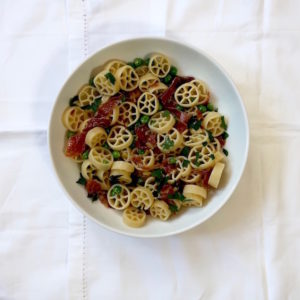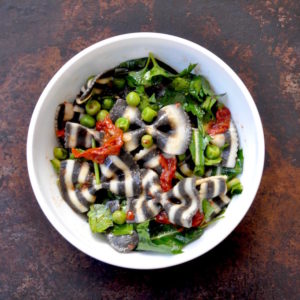Cooking ahead
Last month, while waiting to get a corticosteroid shot in my spine, I went on a major cooking/baking/freezing jag, much of it between three and six am.

Cooking was a way of maintaining some control, however tenuous.

The recipes below offered succor both before the injection and afterward, when your hostess was in no mood to cook.

All these dishes freeze and reheat well. Of course, you need not wait for medical woes to prepare and eat any of these dishes. In fact, you shouldn’t.

Diana Henry’s Pacific Lime Chicken
Adapted from Pure Simple Cooking.
Yield: enough for 2 people with leftovers
Prep time: Pacific Lime Chicken benefits from marinating, but I’ve thrown the dish together, let it sit for ten minutes, and shoved it in the oven. It’s delicious either way. Actual preparation time is minimal.
You’ll need a small bowl and a large baking dish to make this.
4-6 large chicken thighs, skin on, bone-in, the best you can afford
4 tablespoons soy sauce (see notes)
2-5 tablespoons honey (a matter of personal preference, but don’t use less than two)
juice of 4 limes (see notes)
3-4 large garlic cloves, crushed, peeled, and minced
Brown or palm sugar: 1/4 teaspoon-one tablespoon (see notes)
about a tablespoon of fresh black pepper
Instructions
If you can marinate the chicken, great: four hours is optimal. It not, not.
When ready to cook, preheat the oven to 350C/180F
Arrange chicken in single layer in the baking dish.
Combine the soy sauce, honey, lime juice, garlic, sugar, and pepper in a small bowl. Pour over the chicken. Marinate chicken 10 minutes-4 hours. Refrigerate chicken if marinating over ten minutes; bring to room temperature before cooking.
Cook chicken for about an hour, checking to ensure liquid does not run dry; if it i does, add a little white wine or water.
Chicken is done with a knife is easily inserted near the bone, meat is no longer pink, and juices run clear.
Eat. Or allow chicken to cool completely and freeze in a freezer-proof container up to two months.
For health and safety reasons, I should instruct you to defrost chicken overnight in the refrigerator. Consider yourself told. I remove it from the freezer and leave it on my kitchen counter for several hours, checking frequently. Once the chicken is defrosted, I refrigerate it until serving time.
Pacific Lime Chicken is ideally reheated in a low oven, but when you’re recovering from illness or other medical interventions, the microwave oven will suffice. The chicken skin won’t be crisp, but you probably won’t care.
Pacific Lime Chicken pairs well with almost any side: rice, noodles, couscous, bread, potatoes, bagged salad greens, any vegetable you have around.
Refrigerate leftover chicken up to four days; it’s delicious at any temperature and makes wonderful sandwiches.
Notes:
Henry cooks her chicken at 375F/190C; you can, too, but check to ensure the skin is browning, not burning. If it’s too dark, either cover it with foil or turn the oven down.
I depart from Henry’s recipe in a few ways: I often skip the tablespoon of brown sugar called for, or reduce it to a quarter teaspoon. The recipe also calls for thyme sprigs, which live in my freezer and in this case, tend to stay there.
The recipe calls for dark soy sauce. Regular soy sauce is fine if you don’t have dark.
I don’t always have limes in the house. Lemons are another story. I’ve made this dish using all lemon juice and a mixture of lemon and lime juices. Both were good.
Component Pasta Salad with Olives, Capers, and Parsley (Aka John’s Birthday Pasta)
John’s birthday was the day after my injection. He was spending the day at a local National Park, necessitating a packed lunch.
Pasta salads aren’t known for improving when prepared ahead of time. Counter this by packing your ingredients separately. The successful result is useful for picnicking types.
Prep time: about 30 minutes
Serves: People argue about pasta servings. I made 12 ounces, serving two people who were spending the day outdoors. (I was not one of them.)
12 ounces/340 g tubular dried pasta
approximately 2 tablespoons parsley, minced
1 scallion, thinly sliced.
1 tablespoon salted capers, well rinsed and lightly chopped
generous handful olives, pitted and lightly chopped
1 lemon, sliced in thin rounds and seeded
approximately 1/4 cup/2 ounces/56 grams Pecorino Romano or Parmesan cheese
About four tablespoons/110g good olive oil
Optional additions:
pine nuts
diced ham
Serrano ham
Crumbled feta or goat cheese
A pinch of dried hot hepper flakes
Instructions
You will need a large pot, a colander, and a heat-proof measuring cup to make this pasta. If you are packing it ahead of time, have several small containers ready. I use plastic cream cheese containers.
Fill a large pot with heavily salted water and bring it to a boil. Add the pasta and cook until al dente or to your liking (we prefer our pasta softer than al dente.).
Before draining the pasta, carefully dip a heat-proof measuring cup in the water, removing about one cup/236 ml. Or, more safely, ladle the water into the heat-proof measuring cup.
Drain pasta, but don’t shake off all the water. Return pasta to pot. Add enough of the reserved pasta cooking water to keep the pasta creamy without waterlogging it. Stir and allow to cool. Reserve any remaining pasta water.
Slice or chop remaining ingredients, packing them into separate containers. I paired like ingredients: the parsley with the scallion, the olives with the capers. You get the idea.
Once the pasta is cool, add the remaining water and stir. Transfer pasta to lidded container.
Refrigerate all ingredients until needed.
On the day you plan to eat the pasta, add olive oil to your taste. At serving time, stir in remaining ingredients, or allow diners to customize their pasta.
Leftover pasta salad will keep, refrigerated, four days. Do not freeze.
Plain Pork Chops
Scarcely a recipe, but handy.
Prep time: about 30 minutes
Serves: make as many as you like; I made three chops, serving two people for dinner and one for lunch the next day.
Instructions
Make sure pork is at room temperature before cooking. Cook in a frying pan or roast in the oven; I used the oven.
Preheat oven to 350F/180C
Arrange pork chops in a baking dish.
Squeeze lemon juice over the pork chops. Salt and pepper lightly. Scatter garlic over, if using. Add enough white wine or Vermouth to generously coat bottom of pan. Pour in about two tablespoons of olive oil.
Place chops in oven. Bake, checking at 20 minute mark, adding more liquid if necessary. You don’t have to turn the chops over, but if you want to, go ahead.
Pork is like fish, going from perfect to dry in moments. Check for doneness by slicing at the bone: meat should not be raw pink. Juices should run clear. Depending on your pork, this can take 20-35 minutes of cooking.
Eat immediately, or cool and freeze up to two months. Defrost in refrigerator. Reheat in microwave or low oven.
Plain pork is amenable to being dressed up or eaten as is. Spicy sauces like Sriracha are good, as is soy sauce, a sprinkling of fresh herbs, or even a vinaigrette of olive oil and more lemon juice. Eat with noodles, rice, or salad greens.
Note:
If you are planning to eat the pork immediately, you can add a few vegetables to the roasting pan: sliced onions, carrots, radishes (yes, radishes) or fennel are all good.





